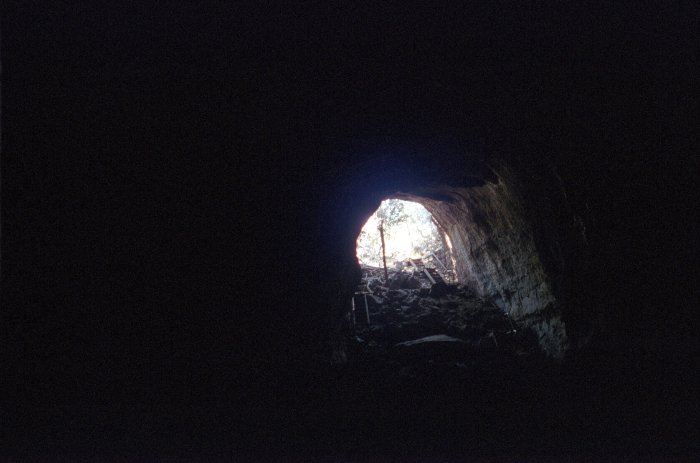|
|
|
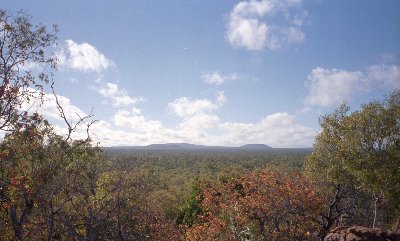 Chris
booked our accommodation and day tour as we drove from Carnarvon
Gorge to Undara. After staying in a cold small tent and driving
1100K - a soft bed was a good thing. I am not a fan of resorts but
was impressed with Lava lodge. We didn't want five star service
just access to the tubes. We stayed in a "cabin" which
was very basic, they were approx 3 Mtr cubes with two beds, power
and a fan – no fridge. There was a nice outdoor communal BBQ
area which we had to ourselves because only two or three of the
twelve cabins were occupied. We arrived after closing time and the
staff were very helpful in provided after-hours key pickup. There
are a range of accommodation options from posh to camping. At a
bit over $16 per head the cabin was good value. Chris
booked our accommodation and day tour as we drove from Carnarvon
Gorge to Undara. After staying in a cold small tent and driving
1100K - a soft bed was a good thing. I am not a fan of resorts but
was impressed with Lava lodge. We didn't want five star service
just access to the tubes. We stayed in a "cabin" which
was very basic, they were approx 3 Mtr cubes with two beds, power
and a fan – no fridge. There was a nice outdoor communal BBQ
area which we had to ourselves because only two or three of the
twelve cabins were occupied. We arrived after closing time and the
staff were very helpful in provided after-hours key pickup. There
are a range of accommodation options from posh to camping. At a
bit over $16 per head the cabin was good value.
This is the
first place Val took us – a lookout to survey the terrain.
The hills in the distance are extinct volcanoes – I don't
remember if the Undara volcano is one of them. The country is
rough, get lost and you will probably die of thirst – don't!
Search and rescue costs $100,000 a day and doesn't always succeed.
|
|
|
|
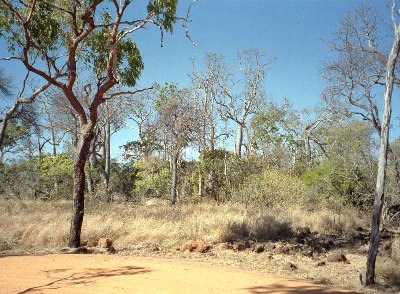 The
park was a cattle property and the owner (Stan Colins) had the
sense to switch from cattle to tube tours and has done a good job
of creating the operation – unlike some other resort owners
in Queensland. The day tour was $93 and well worth it. Morning
tea, lunch and afternoon tea are provided. The tourists on our
trip tended to be middle aged and older – with a few
exceptions. No great fitness is needed but there are a few ladders
to climb and rocks to scramble over. In the morning we had a mix
of full and half day tourists so the bus was full – about 20
people. In the afternoon we only had seven or so. The
park was a cattle property and the owner (Stan Colins) had the
sense to switch from cattle to tube tours and has done a good job
of creating the operation – unlike some other resort owners
in Queensland. The day tour was $93 and well worth it. Morning
tea, lunch and afternoon tea are provided. The tourists on our
trip tended to be middle aged and older – with a few
exceptions. No great fitness is needed but there are a few ladders
to climb and rocks to scramble over. In the morning we had a mix
of full and half day tourists so the bus was full – about 20
people. In the afternoon we only had seven or so.
Much of the
tour had nothing to do with tubes, Val told us all sort of stuff
about the land, plants animals, geology and history of the place.
Some people call this "padding" but I learned a lot that
day.
The collapsed tubes can be seen from a distance because
the different vegetation in them. They shelter a dry rain-forest.
Dry rain-forest strikes me as a rather dumb name. The tube
contains this forest not because it rains there (imagine long rain
clouds 10 meters wide just raining in the tubes) it is there
because the plants are fire sensitive and the walls keep fire out.
At this time of year the trees in the tubes have lost their leaves
and stood out from the surrounding bush.
|
|
|
|
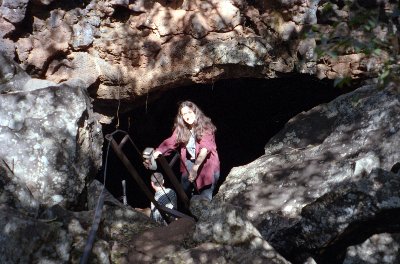 Here
Chris is climbing down the ladder into our first tube while
holding a standard issue torch – I brought my own which was
somewhat more reliable. The first few tubes didn't require a torch
but we needed them before returning to the bus. This small tube
doubled as a classroom with Val showing some posters, maps and
satellite images of the tube system. She also told us about a
self-guided walk around a crater rim some 12K from the lodge. We
did this the next day and its worth doing to get a better view of
the surrounding country side. Here
Chris is climbing down the ladder into our first tube while
holding a standard issue torch – I brought my own which was
somewhat more reliable. The first few tubes didn't require a torch
but we needed them before returning to the bus. This small tube
doubled as a classroom with Val showing some posters, maps and
satellite images of the tube system. She also told us about a
self-guided walk around a crater rim some 12K from the lodge. We
did this the next day and its worth doing to get a better view of
the surrounding country side.
Some of the tubes are "walk
thru" some are dead ends and one was a 'tick' shape. This was
a forked tube with a collapse in the right hand branch near the
join and silted up just past the join – this is the "wind"
tunnel. Wind is important because it prevents (pre-vents?) bad air
from accumulating. The deep dead end tubes can have this problem
and this limits which tubes can be entered and how deep you can
go. The longest tube we entered was around 800 meters long but it
was only safe to go 350 meter inside – it feels like much
further though.
|
|
|
|
|
|
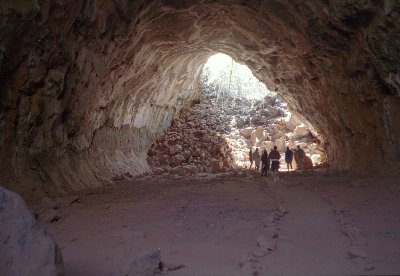 Aboriginal
artifacts are rare, however this tube had a few. Visitors are
expected to stay within defined walking tracks to preserve as much
of the floor as possible. In some tubes the silt is deep and may
contain objects of archeological value. The floor may continue to
deepen over time with a tourist layer currently forming. Further
archeologists may carefully note 2 lines of stones buried in this
layer. Hopefully they won't find cigarette butts and chips
packets. Aboriginal
artifacts are rare, however this tube had a few. Visitors are
expected to stay within defined walking tracks to preserve as much
of the floor as possible. In some tubes the silt is deep and may
contain objects of archeological value. The floor may continue to
deepen over time with a tourist layer currently forming. Further
archeologists may carefully note 2 lines of stones buried in this
layer. Hopefully they won't find cigarette butts and chips
packets.
The caretakers try to minimize interference and will
(for example) leave dead animals in place. This cave contained a
dead dingo which had died there a few years ago.
Every tube is
different - different plan-forms, profiles and floor depths –
also some are wet but most are dry. The wet ones have tree roots
in them.
|
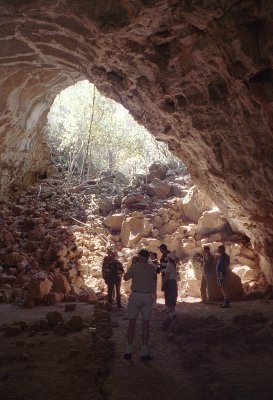
|
|
|
|
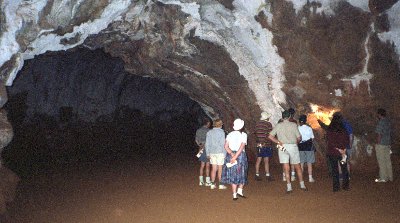 The
walls are quite different to other caves I've visited. The white
is calcite but walls are volcanic rock not limestone or sandstone.
The calcite forms cave coral but no stalagmites or stalagtites.
Instead of limestone formations there are distinct lava formations
– sags and dribbles and lavaicles. There are domes and bowls
formed by eddy currents in the lava. The
walls are quite different to other caves I've visited. The white
is calcite but walls are volcanic rock not limestone or sandstone.
The calcite forms cave coral but no stalagmites or stalagtites.
Instead of limestone formations there are distinct lava formations
– sags and dribbles and lavaicles. There are domes and bowls
formed by eddy currents in the lava.
|
|
|
|
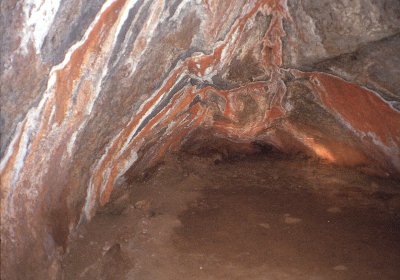 The
tube are not level, one would expect them to be (on average)
descending or the lava would not have flowed. The floor is usually
decomposed bat dropping and tends to be more level than the tube.
So when a tube descends the ceiling eventually meets the floors as
it has done here. Where the tube dips and rises again there may be
enough gap to crawl through into the next section but this is for
the experts. This is partly because the air after the restriction
is likely to be foul and the explorers need breathing apparatus
(it would be fun though). The
tube are not level, one would expect them to be (on average)
descending or the lava would not have flowed. The floor is usually
decomposed bat dropping and tends to be more level than the tube.
So when a tube descends the ceiling eventually meets the floors as
it has done here. Where the tube dips and rises again there may be
enough gap to crawl through into the next section but this is for
the experts. This is partly because the air after the restriction
is likely to be foul and the explorers need breathing apparatus
(it would be fun though).
|
|
|
|
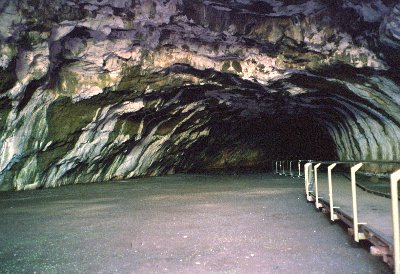 Undara
also caters for the less able-bodied visitors. This tube has wheel
chair access including a solar powered lift for the chairs. The
tube has no artificial lighting installed because introducing
light will change the biology. The green in the photo is Algae
which requires light to live, too much artificial light inside and
you allow algae to grow where it doesn't belong. Another thing
that doesn't belong is the cane toad, which is invading some of
the tubes. Undara
also caters for the less able-bodied visitors. This tube has wheel
chair access including a solar powered lift for the chairs. The
tube has no artificial lighting installed because introducing
light will change the biology. The green in the photo is Algae
which requires light to live, too much artificial light inside and
you allow algae to grow where it doesn't belong. Another thing
that doesn't belong is the cane toad, which is invading some of
the tubes.
|
|
|
|
|
|
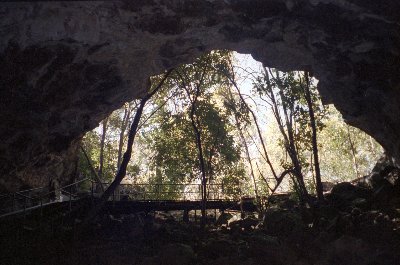 I
found it hard to take in everything I was experiencing. I guess I
imagined being in the tube like being inside a pipe - but it
wasn't. There was much more to see and learn than I expected and
it was hard to take it all in. I'd love to have this in my back
yard so I could spend time alone in there. I'd also take some
descent photos, taking happy snaps with a (cheap) handheld camera
does not do it justice. I
found it hard to take in everything I was experiencing. I guess I
imagined being in the tube like being inside a pipe - but it
wasn't. There was much more to see and learn than I expected and
it was hard to take it all in. I'd love to have this in my back
yard so I could spend time alone in there. I'd also take some
descent photos, taking happy snaps with a (cheap) handheld camera
does not do it justice.
|
|
|
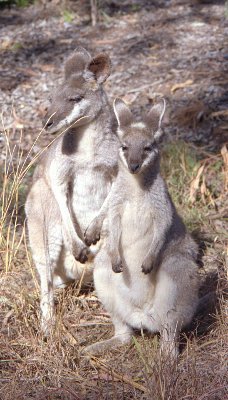
The lodge has a policy
of not feeding the animals. They do provide water though and grow
gardens and lawns. This attracts native animals such has these
"pretty faced" wallabies. Wallabies were getting fairly
boring after seeing so many from the car and bus but I had trouble
rationing my film with these guys (pity I didn't have my digital
camera then). This photo was taken just a few meters from our
cabin window. Perhaps we should have stayed longer and explored
some of some more of the sights outside the park. We've heard the
bush poetry and other night time activities are good but we piked
out.
|
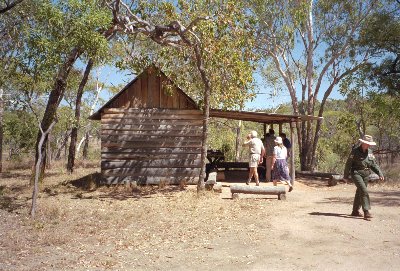
Lunch was served at this replica slab hut. Apart from the screws
holding it together it looked pretty authentic. Lunch was a self
serve smorgasbord affair with billy tea and all that. At lunch you
get to know the other visitors and bit better. Our group was
mostly Ozzie with one kiwi couple and one guy from Finland. I
think most were motor touring as we were.
|
|
|
|
http://www.undara-experience.com.au/
Up one level
Eddie's
Home Page
|
